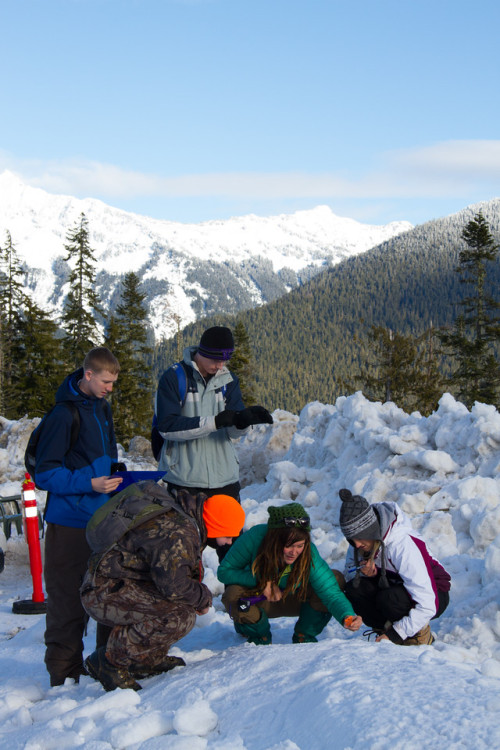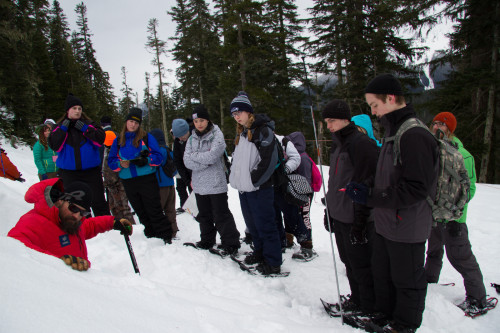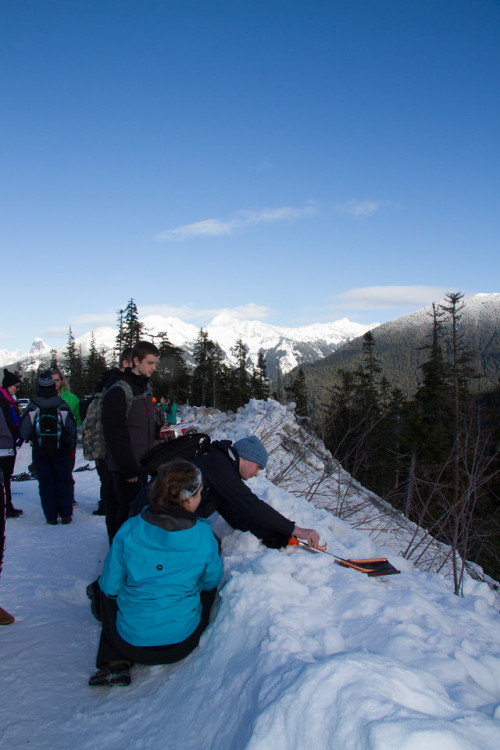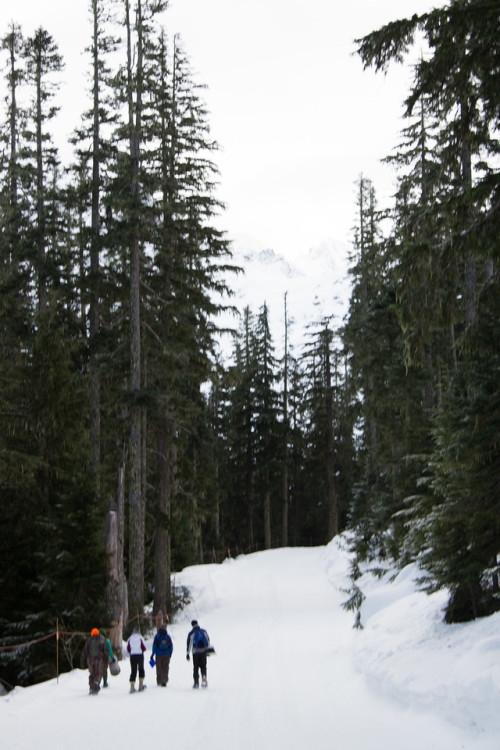Snow School 2016: Experiential Education on Mt. Baker

On a rainy Friday morning in Bellingham, eight environmental educators cram tightly into a van fully equipped in winter gear. The van’s destination—Mt. Baker Ski Area. Rain continues to fall heavily in the lowland forests of the Nooksack Valley as the van makes its way toward the mountain. Soon we’re steeply ascending toward the Ski Area and as we pull into the parking lot we hit a magic line where the rain turns to thick, wet and heavy snowflakes. We have an hour to prepare for the day until a school bus arrives with a hoard of 8th grade students from Mt. Baker Middle School in Deming, WA.
Upon arrival, the students seem excited but also unsure for what’s in store for the day. The environmental educators, with lesson plans prepared, await to go explore the nearby snowy mountain terrain with these eager students who will be heading into the field to collect data and observations on weather, snow pack and snow stability.
Based out of the Mt. Baker Ski Area, Mt. Baker SnowSchool is a collaboration between the Mt. Baker Ski Area, North Cascades Institute, Northwest Avalanche Center, Mt. Baker-Snoqualmie National Forest and The Winter Wildlands Alliance.

Northwest Avalanche Center instructor Jeff Hambleton teaches students to identify layers in the snowpack.
Following a pre-trip program orientation in their school classroom, students visit the Mt. Baker Ski Area to get outdoors for some experiential, hands-on learning unique to our place and location here in the wet, steep world of the North Cascades. The program runs each Friday from January through March. Students range from 7th to 12th grade and are from schools primarily in Whatcom County.
The Mt Baker region receives an average of 50 feet of snow a year! This large snow pack, combined with steep terrain, heavy winds and a wide range of temperatures, creates a prime location for avalanches. And the Mt. Baker Ski Area makes for an excellent classroom to safely observe and learn about the impacts of weather and snowpack in the North Cascades on the landscape.
During the one-day program, SnowSchool students strap on snowshoes—many of whom are experiencing these winter gadgets for the first time—and explore the winter environment within the bounds of the Mt. Baker Ski Area based out of the White Salmon Lodge. While at the Ski Area, students spend about three hours snowshoeing with their trail group instructors—who primarily consist of student interns and volunteers from Western Washington University. Alongside their instructors, students collect snow and weather data as they learn how to read the surrounding terrain, what to look for when assessing avalanche danger, and how certain weather conditions can play a vital role in avalanche behavior.
In addition, students spend time with a snow scientist from the Northwest Avalanche Center who teaches participants about snow pack and stability. Using the same field techniques used to compile data for avalanche prediction, students work with the snow scientist to gather snowpack data using the snow pit test to identify the layers deep within the snowpack and then determine the stability of the snowpack with a stress test.

The combination of practical, scientific experience and exploration in the mountains creates one great encounter unique to our place in the country.
As a Snow School instructor, I have the opportunity to see the program first-hand. It is not all too often that students in the United States have the chance to experience placed-based experiential education relating to their local, outdoor environment—especially in a landscape like the North Cascades. From my experience, it is clear that the students, even in the wet, cold weather, relish in the opportunity to get out into the mountains to play, learn and conduct field science. In learning about the importance of forecasting, field investigations and avalanche safety, students are also exposed to the importance of snow to the local Nooksack watershed. The program is a well-rounded experience allowing instructors and students alike the experience of connecting with the local mountain ecosystem through learning and playing in the outdoors during the wetter months of the Northwest.

All photos courtesy of Codi Hamblin

